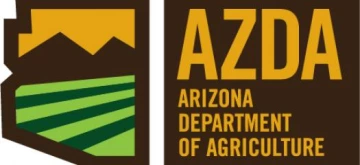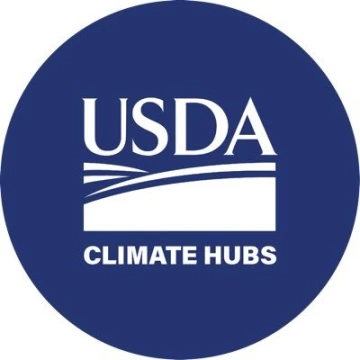< Back to Climate Viticulture Newsletter
Hello, everyone!
This is the June 2024 issue of the Climate Viticulture Newsletter – a quick look at some timely climate topics relevant to wine grape growing in Arizona.
IN THIS ISSUE
- A Recap of May Temperature and Precipitation
- The Outlook for June Temperature and Precipitation
- Heat Accumulation during the Growing Season
- Extra Notes
A Recap of May Temperature and Precipitation
Monthly average temperatures were within 2 °F of the 1991-2020 normal for almost all of Arizona (light blue, white, and light orange areas on map), including the Sonoita, Verde Valley, and Willcox AVAs. For reference, monthly average temperatures in May last year also were within 2 °F of normal for almost all of the state.
Area-average maximum and minimum temperatures during May 2024 were 82.0 and 47.6 °F for the Sonoita AVA, 84.2 and 48.8 °F for the Verde Valley AVA, and 83.7 and 47.8 °F for the Willcox AVA. Respective May normals are 81.7 and 49.6 °F, 84.5 and 50.0 °F, and 84.8 and 48.9 °F.
Temperature last month ranged between 94.3 and 37.6 °F at the AZMet Bonita station and between 96.4 and 38.5 °F at the AZMet Willcox Bench station.
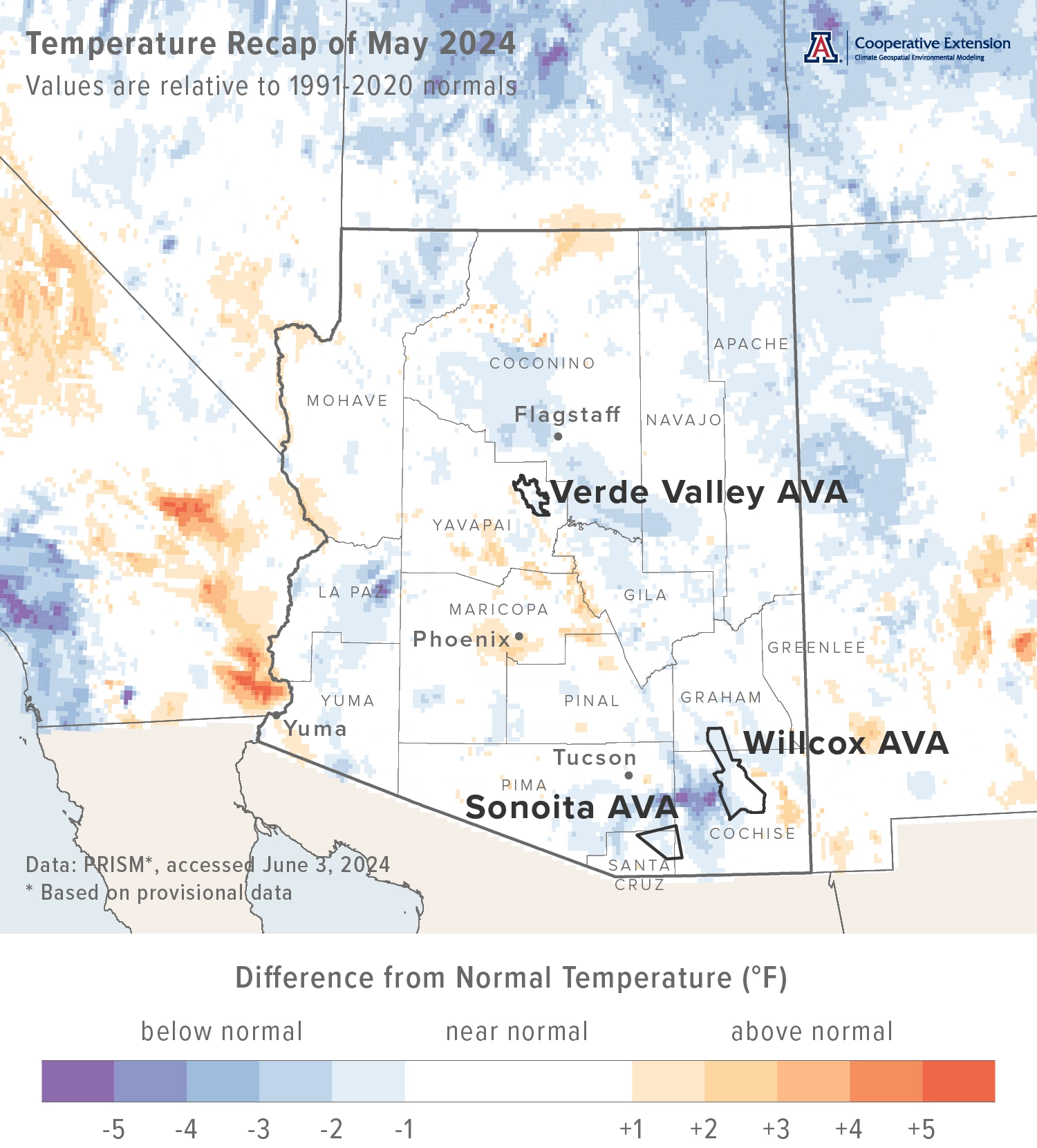
Jeremy Weiss
Monthly precipitation totals were less than 25 % of normal for almost the entire state (dark yellow area on map), including all three Arizona AVAs. Precipitation during May 2023 was more than 150 % of normal for many areas in the west-central and southeastern parts of the state. Otherwise, and apart from much of the southwestern and south-central parts of the state that measured amounts below 50 % of normal, monthly totals mostly were near normal.
Area-average total precipitation in May 2024 was 0.00 inches for the Sonoita AVA, 0.00 inches for the Verde Valley AVA, and 0.00 inches for the Willcox AVA. Respective May normals are 0.22, 0.44, and 0.29 inches.
Total precipitation last month was 0.00 and 0.00 inches at the AZMet Bonita and Willcox Bench stations, respectively.
Dig further into daily weather summaries for the AZMet Bonita and Willcox Bench stations in the Willcox AVA
Learn more about PRISM climate data
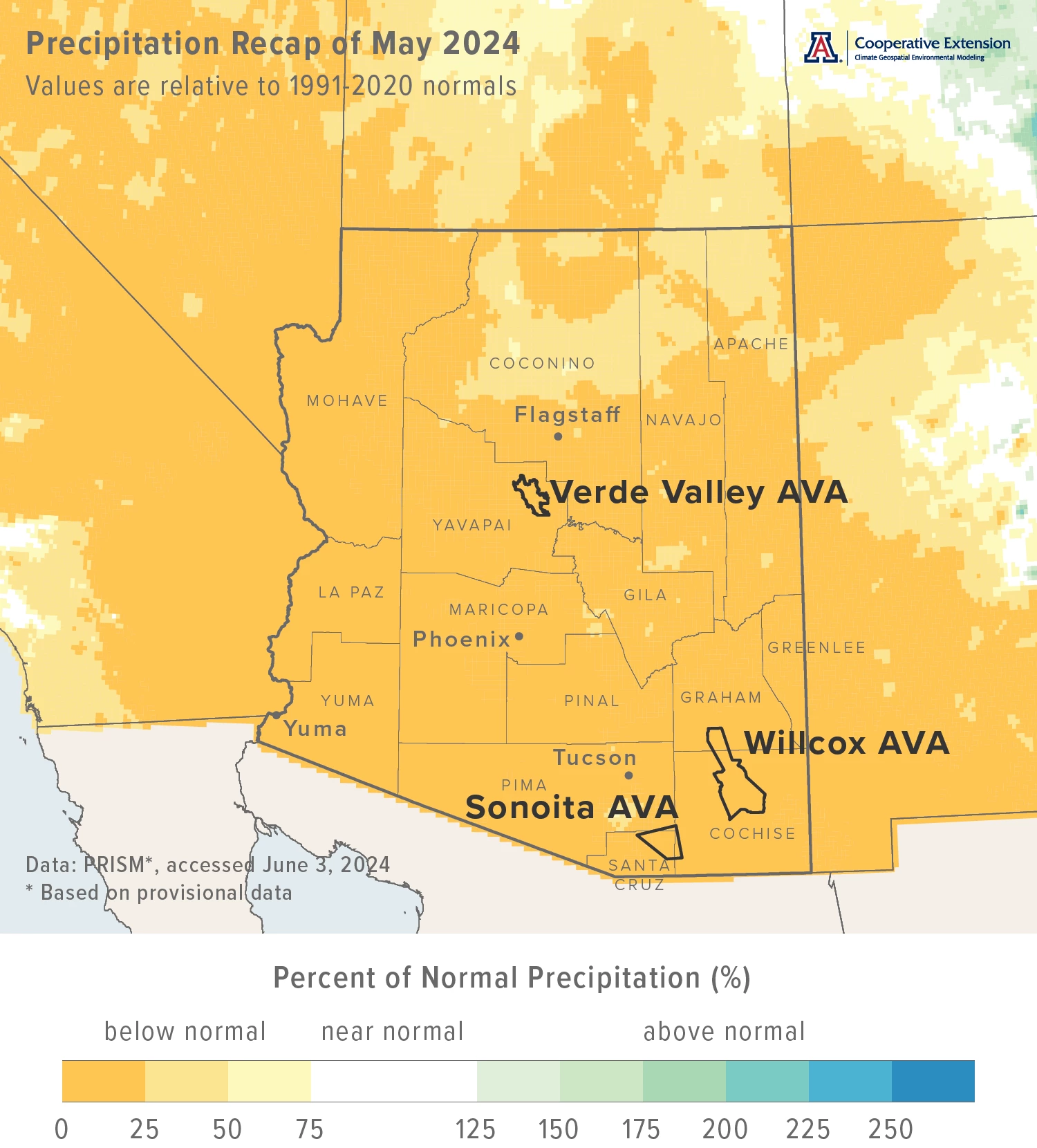
Jeremy Weiss
The Outlook for June Temperature and Precipitation
Temperatures over the course of this month have a slight increase in chances for being above the 1991-2020 normal across the southwestern two-thirds of Arizona (light orange and orange areas on map). For the northeastern one-third, there is a moderate increase in chances for above-normal temperatures (dark orange area on map). Monthly average temperatures in June last year were 1 to 4 °F below normal for much of the southeastern and east-central parts of the state, while much of the rest measured temperatures even further below normal.
Area-average maximum and minimum temperatures during June 2023 were 88.2 and 54.9 °F for the Sonoita AVA, 91.0 and 53.8 °F for the Verde Valley AVA, and 91.3 and 54.6 °F for the Willcox AVA. Respective June normals are 90.6 and 59.0 °F, 95.4 and 58.4 °F, and 94.5 and 59.1 °F.
Temperature in June last year ranged between 102.7 and 44.4 °F at the AZMet Bonita station and between 104.2 and 44.8 °F at the AZMet Willcox Bench station.

Jeremy Weiss
Precipitation totals for this month have equal chances for being below, near, or above normal for all of Arizona (white area on map). Precipitation during June 2023 was less than 25 % of normal for the southern two-thirds of the state, and between 25 and 125 % of normal for the northern one third.
Area-average precipitation totals in June 2023 were 0.00 inches for the Sonoita AVA, 0.01 inches for the Verde Valley AVA, and 0.00 inches for the Willcox AVA. Respective June normals are 0.55, 0.18, and 0.42 inches.
Total precipitation in June last year was 0.00 and 0.00 inches at the AZMet Bonita and Willcox Bench stations, respectively.
Like most other past years at this point in the growing season, we don’t know much about what the monsoon will deliver and the conditions under which wine grapes will ripen. We do, however, already know what the possible impacts to the vineyard are and which varieties are more affected, regardless of the temperatures and precipitation totals that appear over the next few months. Impacts from just the past few growing seasons represent the current range, as record-hot, record-dry, and record-wet conditions occurred for many locations. Monsoon hedging is one way to modify exposure to and lessen the magnitude of such impacts. Some hedges in the vineyard are having early and late varieties, varieties that hold pH under hot conditions, and varieties that are resistant to rot under wet conditions. Some hedges in the winery are being able to switch between varietal wines and blends, and between early-pick sparkling and normal- to late-pick table wines. The idea is to have a variety lineup and enough adaptability in the winery to limit losses from unfavorable conditions that occur during ripening and harvest. We might be biased, but we think the monsoon makes the vintage. Monsoon hedging helps ensure that it’ll be a better one overall.
To stay informed of long-range temperature and precipitation possibilities beyond the coverage of a standard weather forecast, check in, too, with the six-to-ten-day outlook and eight-to-fourteen-day outlook issued daily by NOAA’s Climate Prediction Center.
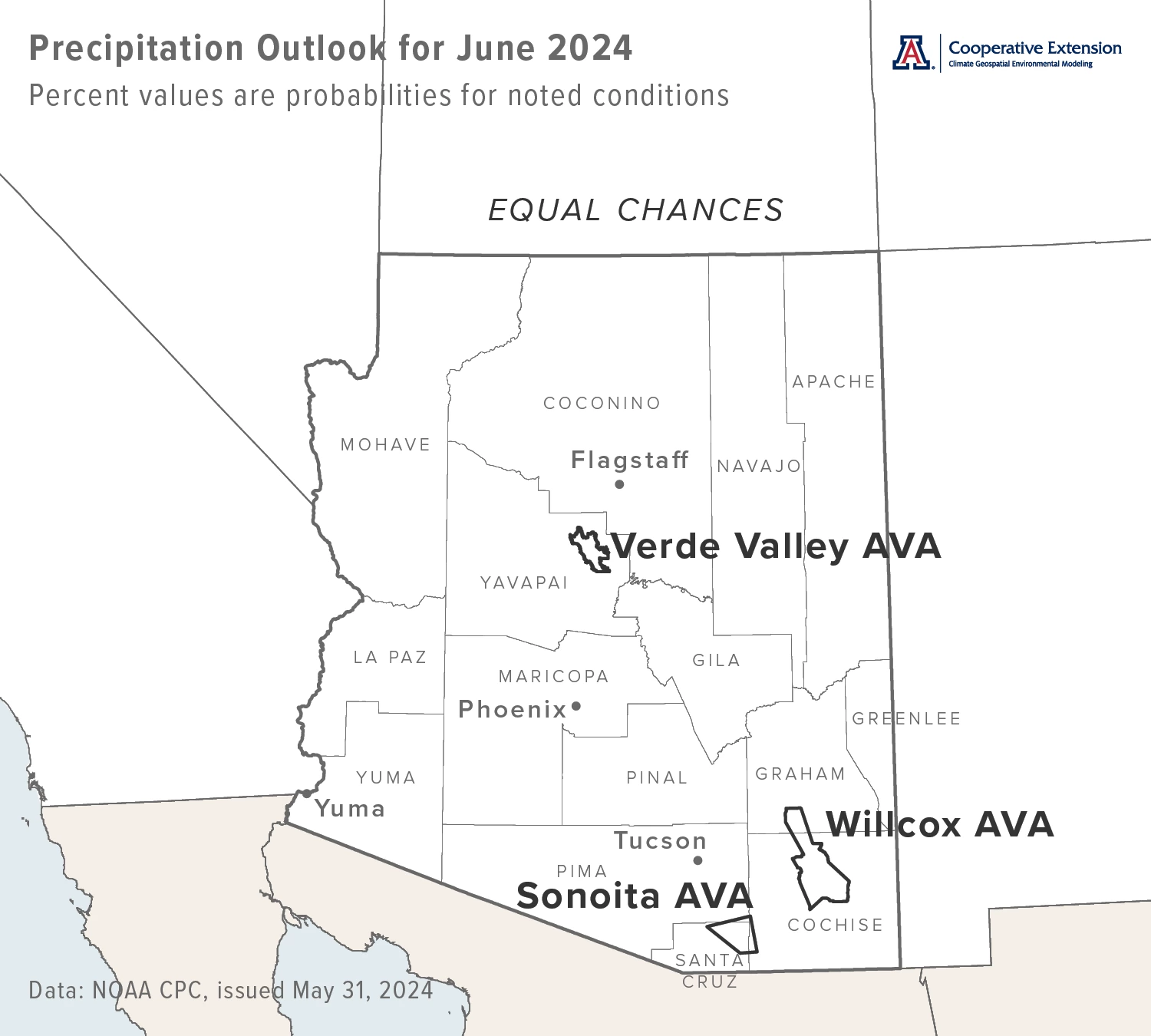
Jeremy Weiss
Heat Accumulation during the Growing Season
Heat accumulation from April through May this year at the AZMet Bonita and Willcox Bench stations (dark gray bars on graphs) is less than what it was at this time last year. This suggests that vine growth rate and time between pre-veraison growth stages may have been slower and longer so far this growing season than what they were in the previous one. Also, heat accumulation is greater at AZMet Willcox Bench than at AZMet Bonita, suggesting that a given variety in the south-central part of the Willcox AVA is at a more advanced growth stage than in the northern part, all else equal. Over the past four years, the greatest amount of heat accumulation for both locations at this point in the growing season happened in 2022.
Unlike previous years, we’re using heat units with an upper threshold of 94 °F and a lower threshold of 55 °F to measure heat accumulation. With heat units, in theory, plants slowly start to progress through growth stages near the lower threshold, reach an optimal development rate at temperatures between the lower and upper thresholds, and progressively slow development near the upper threshold. Outside of the range between the lower and upper thresholds, plant development does not occur. Heat Units 94-55 °F is one of the heat unit variables provided by AZMet and the one with upper and lower temperature thresholds closest to what we’ve read are those for wine grapes.
Is this best measure of heat accumulation for modeling growth stages of wine grapes in Arizona? We don’t know. Nonetheless, it provides a relative characterization of conditions thus far this growing season. We’re looking to work on answering this question in the coming months.
More information on the calculation of heat units is in Extension bulletin AZ1602 'Heat Units'. A data tool to calculate cumulative heat units by station and date range is available on the AZMet website.
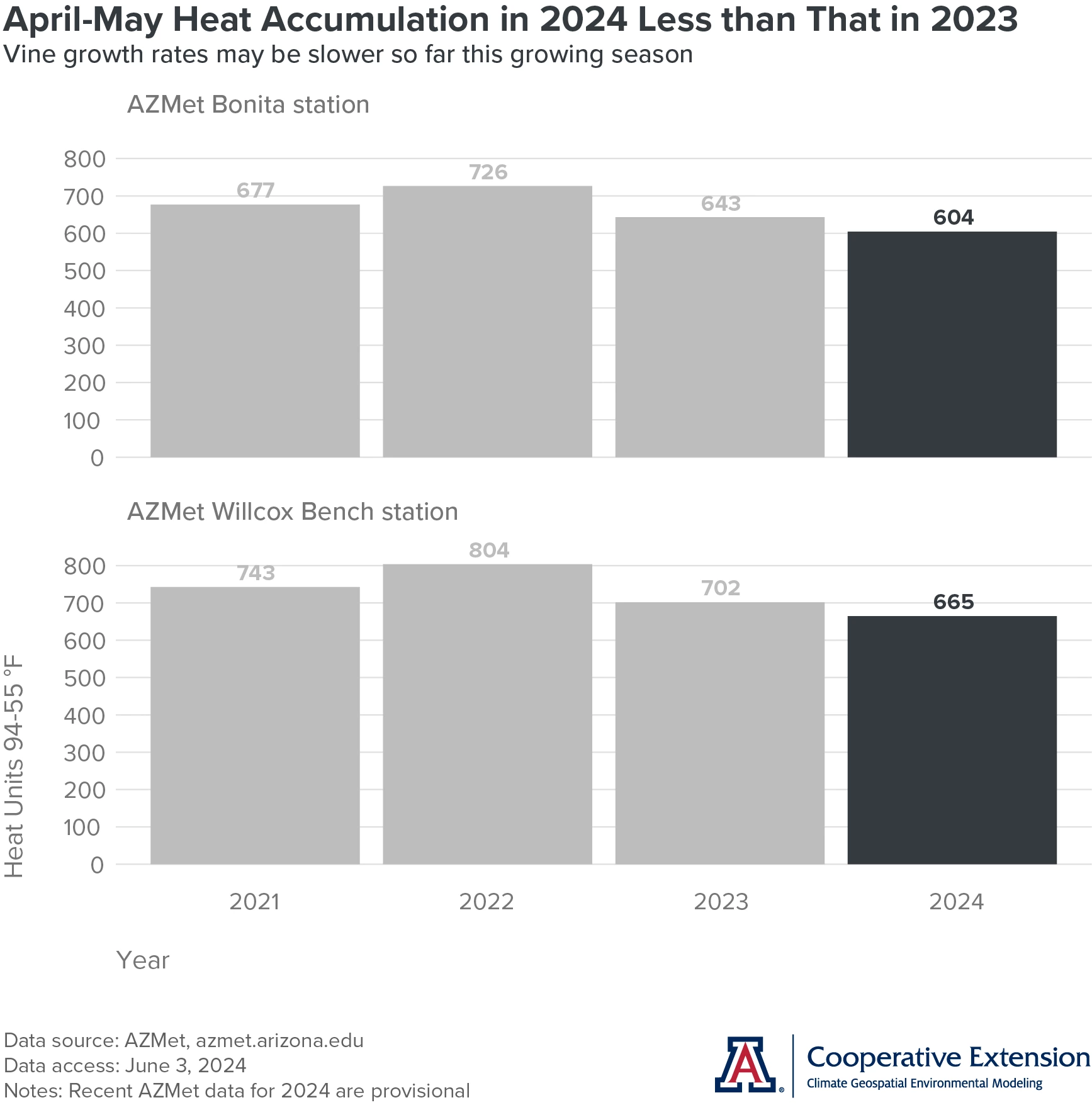
Jeremy Weiss
Extra Notes
A new Extension bulletin on the recent statewide commercial viticulture needs assessment is now available. Based on input from viticulturists and vineyard managers and owners, priority topics include irrigation, pest and insect management, disease management, soil fertility, weather, and weed management.
Given recent and current conditions, there is an above-normal potential for significant wildland fires across the southeastern and east-central parts of Arizona in June. Otherwise across the state, the outlook from the National Interagency Fire Center shows potential as normal for the month.
Historically, there has been a tendency for a La Niña event to develop in the months following a strong El Niño event. With the latter now wrapped up, odds are 49 % that La Niña conditions take hold across the tropical Pacific Ocean during the June-through-August period, and 69 % during July-through-September period.
For those of you in southeastern Arizona, including the Sonoita and Willcox AVAs, Cooperative Extension manages an email listserv in coordination with the Tucson forecast office of the National Weather Service to provide information in the days leading up to agriculturally important events, like heat waves and high-wind days. Please contact us if you'd like to sign up.
And for those of you in north-central and northeastern Arizona, including the Verde Valley AVA, Cooperative Extension also now manages an email listserv in coordination with the Flagstaff forecast office of the National Weather Service to provide similar information for this part of the state. Please contact us if you'd like to sign up.
Undergraduate students in the College of Agriculture and Life Sciences at the University of Arizona are looking for internships with businesses and companies in the viticulture and winery industries. Please contact Danielle Buhrow, Senior Academic Advisor and Graduate Program Coordinator in the Department of Agricultural and Resource Economics, for more information.
Please feel free to give us feedback on this issue of the Climate Viticulture Newsletter, suggestions on what to include more or less often, and ideas for new topics.
Did someone forward you this newsletter? Please contact us to subscribe.
Have a wonderful June!
With current and past support from:
